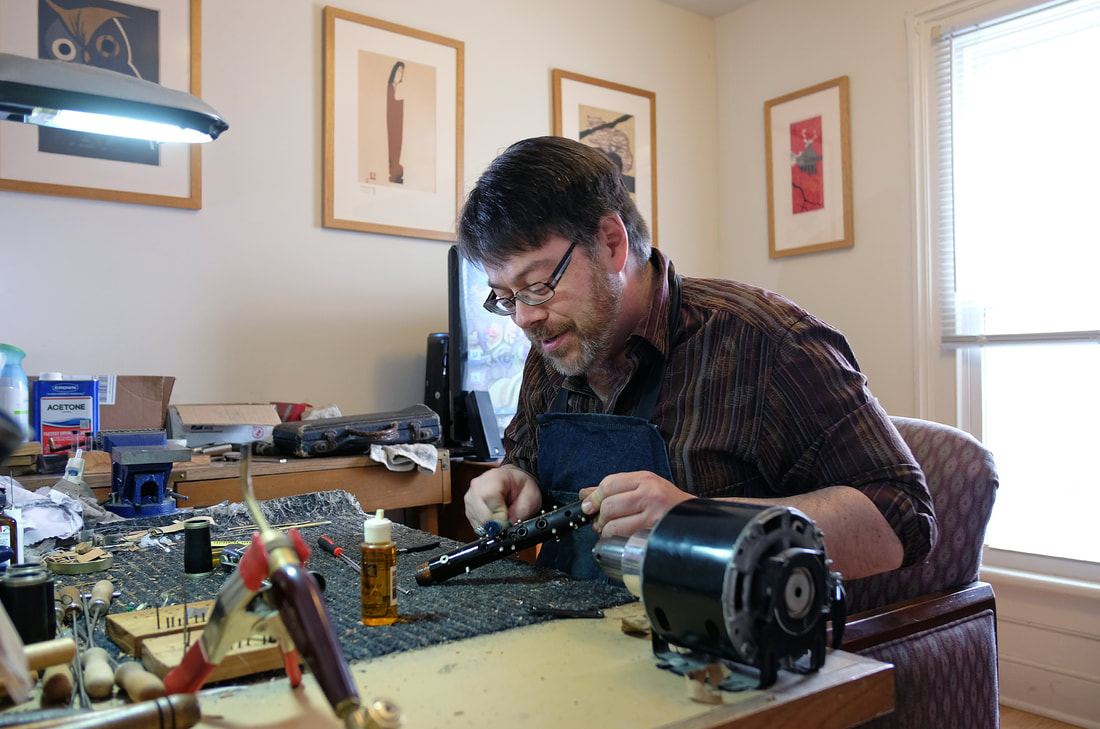 With the pre-school (clarinet) shopping season upon us, it seems like a good time to broach the question; why should you spend your hard earned dollars on a vintage clarinet rather than a new instrument? Here are a few thoughts... 1) The retail markup has already been paid: Instead of $600 for a new plastic or $1800+ for a new wood instrument, how about $400-800 for a fully refurbished intermediate or pro quality wood clarinet? The price represents the initial cost of a vintage instrument, shipping, overhaul (buffing, pads, cork, etc), photography, writeup and customer service time. You can speak directly to the technician that restored the instrument, who will take time to answer your questions and find the best horn and mouthpiece for you. Then, you can put the rest of your money back in the bank. 2) Quality materials: Instead of a body made of plastic or cheap dyed wood sporting plated, cast metal keys, you'll get grenadilla wood of a quality rarely seen any more and solid nickel alloy keys hand soldered for strength and durability. These old horns were built to last and will give you years of dependable service. 3) Quality construction: these horns were built by craftsmen with pride in their work, not just an eye for the bottom line. Many features that were once common, like post locks, solid nickel keywork and fittings, and extra keys to facilitate challenging passages are rarely seen except on the most expensive modern horns. Also, many old horns received more tuning time than modern budget instruments and still play well in tune after many years. I've sold more than a few high end vintage clarinets to players who subsequently sold their modern Buffets after comparing the two... 4) More choices: instead of overpriced Buffets and Buffet clones, there were many fine makes, 50+ years ago, with distinct personalities. Thibouville Freres, SML, Leblanc, Penzel Mueller and many more offered everything from small to extra large bore sizes, custom keywork, and tones from bright to dark and sweet to brazen. Players of Jazz, Klezmer, and various ethnic musics (as well as Classical and commercial) owe it to themselves to experience the range of sounds and feels available with vintage/antique horns and mouthpieces before settling for an expensive, mass produced modern horn. 5) USA made and played: all of these horns were bought/made here, refurbished here, and the money I earn stays here! How many of the big stores (and bigger websites) can say that? We need to move back to American goods and services to revive our economy and I'm happy to help. I could go on, but I think the point is made. Let me know your thoughts, experiences and wishes for the future - please just keep it concise and polite, as this is a public posting....
2 Comments
Stan Alama
5/11/2018 09:34:29 pm
I've very much enjoyed reading your blog articles and other information on older clarinets. As an adult amateur clarinetist who hadn't played in many years, when I came back to the clarinet I purchased a well-preserved 1967 Selmer Series 9 from a local repair shop, at a modest price. I've very much enjoyed playing the Selmer, but am a bit insecure about whether it is appropriate for orchestra or small classical ensemble play. Invariably, all articles which discuss the Series 9 (or offer one for sale) call it a "jazz clarinet". I worry that the tone is too strident for blending in an orchestra-- or is it my own tone which is at fault? Are there serious concerns for playing a 9 in an orchestra? Or is it a question of choosing the correct mouthpiece, or some other adjustment to technique or equipment? Thanks for any advice you may have.
Reply
Pastor Bill Williams
1/4/2019 07:03:45 pm
I am trying to find the serial numbers I have for two older clarinets which I wa given by an old college music professor back in the 60's. I simply cannot find a serial number anywhere on either instrument. The first clarinet is a Jules Gerard (which is my favorite), and the second one is a D. Noblet. It looks like there may also be additional letters under the name which may read TND with the N being larger that the T and D. I have yet to discover any other numbers. I am considering having them gone through by some craftsman who really knows these clarinets, but want to get some idea as to whether that is a prudent direction. I'm 76, and would enjoy playing both clarinets again.
Reply
Your comment will be posted after it is approved.
Leave a Reply. |
Archives
February 2024
AuthorThe Licorice Shtick Blog is the creation of the Vintage Clarinet Doctor, a Winston Salem, NC based woodwind instrument repair shop specializing in vintage and antique clarinets, saxophones, and the occasional flute. Categories |

 RSS Feed
RSS Feed